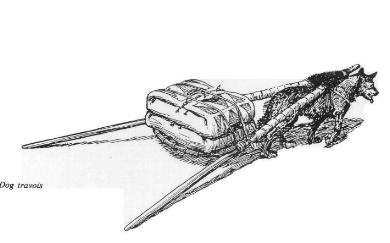|
Song
Dog Kennels
|
|
|
|
Home
of SONG DOG KENNELS -- Sole copyrighted Registry for the AMERICAN
INDIAN DOGS
|
|
The ancestors of the American Indian Dog have been traced as far back as 30,000 years, during the Ice Age in North American. Among the Old Crow people, ancestors of the American Indian, archaeologists have discovered artifacts and bones of domesticated dogs. The American Indian Dogs were studied and documented by early Spanish explorers, Lewis and Clark, and other early naturalists, settlers and trappers. There are three types of Native American dogs: The large wolf-type from the northern Artic area originally bred for sled pulling (Malamutes, Huskies, Samoyeds); Medium sized, coyote-like dogs, once the most common (the American Indian dog; and 3) the smaller Indian Dogs (Tahl-Tan Bear Dog of Canada, Chihuahua of Mexico, Mexican Hairless). The largest population of American Indian Dogs (200,000) was found among the North American Plains Indians; Indian families commonly possessed 10-30 dogs per family. They were also found from the sub-Artic regions through Canada, parts of the U.S. and Peru. Their near-extinction stems from their coyote-like appearance; early settlers killed them as they killed the American Indian Dog's cousin, the coyote. When the White Man arrived and staged his first major battle at Pequot Fort, Massachusetts in 1637, to the massacre of the Sioux band at Wounded Knee, South Dakota in 1890, almost nothing remained of the Native Indian culture, including its dogs. Even after the tribal groups were moved to reservations, the white soldiers and settlers continued to destroy the American Indian Dog. Their starving masters ate some dogs as they were forced from one desolate reservation to another. Many dogs become feral, associating with their wild cousins, the coyote. It is believed this association is why there is such a difference in coyotes from one part of the country to another. The American Indian Dogs are finally being recognized as versatile, loyal dogs, developed from thousands of years of selective breeding by Native American people. Native Americans had great respect for the coyote and believed this "God's Dog' was the first being on earth, and would also be the last. The Indians believed the coyote was here to assist man in survival techniques, and to help him learn the secrets of humility and nature's balance. Female American Indian Dogs were tied out into the open during their estrus cycle to be bred to the coyote, thereby maintaining the breed's survival instincts, pack loyalty and intelligence. Native Americans used dogs to guard their ponies and villages from rival raiding parties. The dogs tracked game and herded buffalo, assisting the Native Americans in killing the ungulates. They helped pack meat back to camp, babysat and entertained children, kept their masters warm during harsh winters, and also dove under water, herding fish into nets. Not only were they eaten in times of famine, they were also sacrificed during spiritual ceremonies; the ultimate honor was to be buried with a high shaman or chief. Description and Personality The American Indian Dog is inquisitive, intelligent, alert and devoted, although they may appear aloof at first introduction to strangers. They are not vicious, yet are protective of their owners, and show great affection and possessiveness. They travel well and adjust to any environment, however, will become shy if not introduced to many people at an early age. American Indian Dogs are very communicative, almost "Talking" in their high-pitched voices; body language is quite expressive. General Appearance: Medium in size, American Indian Dogs are well balanced and swift in appearance. Pelage is harsh and straight, with a thick undercoat, and waterproof, black-tipped guard hairs. Their bushy tail hangs down like a ponytail, and is held straight out while running. Color is natural; all have a natural shading or merging of colors, except for solid black or white versions. There are no splotchy, spotted or heavy lines separating light or dark colors. Fastidiously clean, American Indian Dog can spend most of their tie indoors, although outdoors is preferred. They are sensitive animals, but can readily handle firm training. The American Indian Dog is able to adjust to most lifestyles, and will learn as much as you are capable of teaching them. They will instinctively stay one step ahead of what you are already thinking. A close bond is encouraged at a young age. This unique breed is not a pet for everyone. If you adore nature, would like to save a bit of history, and enjoy an animal, which still possesses many of its natural instincts, perhaps you are the special person who could share your life with an American Indian Dog. If, after being interviewed by at least 2 club officers, you may own and care for an Indian Dog. Song Dog Kennels occasionally has American Indian Dogs available for sale. If you don't believe you could keep an Indian Dog for its entire life, please don't purchase one! It is difficult for these dogs to change owners; a bond has already been formed. You must plan on having this friend for life. This native dog is a part of our heritage and the natural balance of life around us. Thanks to the many people that have researched and supported this endeavor, and those who spent years selecting the correct breeding stock, the American Indian Dog's song will be heard once again. These legendary dogs are a part of our heritage and deserve to be recognized as the versatile, loyal breed that they are. For more information on the American Indian Dog, please contact: Song Dog Kennels, Kim La Flamme, 3600 Lakeshore Dr., Selma, OR 97538 |
Song
Dog Kennels
3600 LAKESHORE DRIVE
SELMA, OREGON 97538
(541) 597-2871
EMAIL

